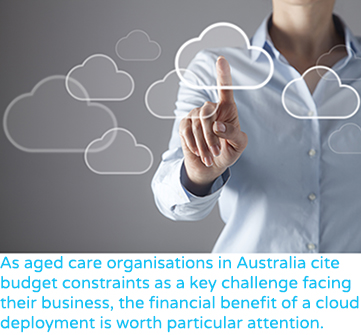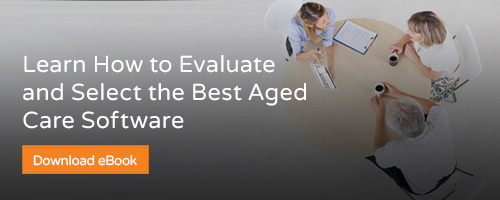 When it all boils down to it, your software systems play a pivotal role in your ability to execute your plans and the results you will achieve. It is, therefore, imperative that your enterprise aged care software solution delivers value and peace of mind in the areas of compliance, data sovereignty, privacy, and security.
When it all boils down to it, your software systems play a pivotal role in your ability to execute your plans and the results you will achieve. It is, therefore, imperative that your enterprise aged care software solution delivers value and peace of mind in the areas of compliance, data sovereignty, privacy, and security.
There is an increasingly compelling argument for moving your enterprise aged care software to the cloud. So, if your organization has not recently explored the benefits of making this shift, 2018 is the year to do so.
As good as three-quarters (74%) of Tech CFO's predicted that the most measurable impact on their business last year would be from cloud computing. This is well supported by IDC data which, as reported by Business Wire, illustrates that in the first half of 2017 the worldwide public cloud services market grew by 28.6% year over year. Notably, the Asia/Pacific region had the largest regional growth; 38.9%.
The aggregate amount of IT spending which shifts from traditional IT offerings to cloud services is already well underway and is estimated that 'cloud shift' in 2020 will reach $220 billion.
Suffice to say the growth of cloud is well documented, so let's explore the advantages of a cloud deployment.
As reported by Business Insider, cloud solutions are gaining in popularity because of the flexibility and cost efficiency it provides. Additionally, Mint Jutras research1 found that businesses using software as a service (SaaS) experienced a broad range of benefits beyond what they expected pre-deployment, including:
- Lower total cost of ownership (24% lower than expected)
- Reduced cost and effort of upgrades (13% better than expected)
- Lower start-up costs (8% greater than expected)
- Ease of remote access for distributed workforce
- Improved IT security
- A more viable business continuity plan
As aged care organizations in Australia cite budget constraints as a key challenge facing their business, the financial benefit of a cloud deployment is worth particular attention. The improved IT security benefit is not to be glossed over either.
The concept of security has come a long way from locked server rooms and bolted down desktop computers. Today, security requires a 24/7/365 mindset within sophisticated electronic operating environments.
 Gartner report that multi-tenant clouds are, as a starting point, more secure than the majority of traditional in-house implementations2. When you consider leading cloud providers deliver best-practice services including complex encryption, intrusion detection and redundancy, it is reasonable to accept that most organizations would have a difficult time matching these capabilities with an internal team. If they could, the economic comparative to the cost of a cloud deployment is also likely to present a compelling case in favour of the cloud.
Gartner report that multi-tenant clouds are, as a starting point, more secure than the majority of traditional in-house implementations2. When you consider leading cloud providers deliver best-practice services including complex encryption, intrusion detection and redundancy, it is reasonable to accept that most organizations would have a difficult time matching these capabilities with an internal team. If they could, the economic comparative to the cost of a cloud deployment is also likely to present a compelling case in favour of the cloud.
Moreover, if your organization has the skills and capabilities of an astute, well-rounded, end-to-end IT team (which many Australian aged care providers don't), wouldn't their time be better spent on more strategic, value-adding activities, rather than IT administration?
With the level of increased competition, being nimble in the current aged care marketplace is essential. To this end, an integrated enterprise aged care software platform can, for example, improve your funding and billing by avoiding the need to operate multiple separate systems just to coordinate back-office activities. Additionally, cloud software such as that provided by Epicor removes the need to justify upgrades, as the latest releases are made available automatically.
With the opportunities and challenges that lay ahead, it is advantageous to harness the value from an integrated business suite which helps manage multiple applications in a single platform. Such a platform should allow everyone to play to their strengths, while automation and an intuitive operating environment drive efficiency at every turn. Anything short of this will attract unwelcome distraction.
With increased investment into a growing market and continued consolidation of aged care providers, those organizations which aspire to grow will need to ensure they can attract and retain the best talent. In 2018 and beyond, that calls for maintaining best-in-class software, amongst other elements that provides a compelling employee value proposition.
The modern employee expects the software solutions they use at work to enable them to be as productive as possible. This speaks to the importance of the fourth listed benefit above from the Mint Jutras research1-ease of remote access for distributed workforce.
 Mobile solutions can empower employees to work remotely. For example, recording data straight into the system rather than handwriting observations reduces time, delays, and human error, key benefits that a cloud solution can provide.
Mobile solutions can empower employees to work remotely. For example, recording data straight into the system rather than handwriting observations reduces time, delays, and human error, key benefits that a cloud solution can provide.
There is a compelling argument for moving your enterprise aged care software to the cloud, yet that does not detract from the importance of a considered process to assess what is right for your organization. If your organization does choose to move its enterprise aged care software to the cloud, then it's important that you establish which partner and platform is the right fit for your organization.
Speaking for our own service offering, the Epicor Senior Living Solution (SLS) offers the exact same solution deployed at a customer's site as it does in the cloud. Therefore, if you opt to deploy in the cloud, the choice is there in the future to move to an on-premises model or vice versa.
* In this article, we refer to cloud as well as SaaS in different cases. The two terms are often used in a similar context, but they do have unique differences. This Mint Jutras guide1, explains the differences well. Essentially, "all SaaS is cloud computing, but not all cloud computing is SaaS."
1Source: Mint Jutras, Benefits Actually Realized from the Cloud, July 2015
2Source: Gartner, “Clouds Are Secure: Are You Using Them Securely?” 22 September 2015, ID: G00281279